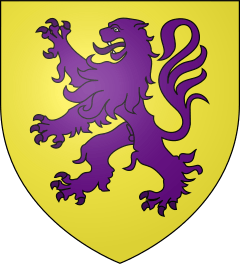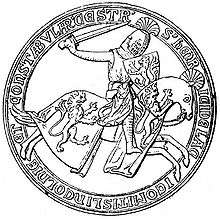Henry de Lacy, 3rd Earl of Lincoln
Henry de Lacy, 3rd Earl of Lincoln, Baron of Pontefract[1] (c. 1251 – February 1311) was an English nobleman and confidant of King Edward I 'Longshanks'. He served Edward in Wales, France, and Scotland, both as a soldier and a diplomat.[2] He was a great grandson of Amadeus IV, Count of Savoy.
Henry de Lacy | |
|---|---|
| Earl of LincolnBaron of Pontefract | |
 Arms of Henry de Lacy: Or, a lion rampant purpure. | |
| Predecessor | Margaret de Quincy, 2nd Countess of Lincoln |
| Successor | Alice de Lacy, 4th Countess of Lincoln |
| Born | 1251 |
| Died | February 1311 (aged around 60) Lincoln's Inn, London, England |
| Buried | St Paul's Cathedral |
| Spouse(s) | Margaret Longespée Joan FitzMartin |
| Issue | |
| Father | Edmund de Lacy, Baron of Pontefract |
| Mother | Alésia of Saluzzo |
Life

Henry was the son of Edmund de Lacy, Baron of Pontefract who died when he was a young child and Alice of Saluzzo she descended from Amadeus IV, Count of Savoy. He was also heir to his paternal grandmother Margaret de Quincy, Countess of Lincoln who died when he was a teenager. As ward to large and important estates from both his father and more importantly his grandmother, he was educated at court.
In 1258 he had inherited his titles and lands from his father, which included Baron of Pontefract, Baron of Halton, and Constable of Chester and in about 1266 he had inherited his titles and lands, which included the Earl of Lincoln, from his paternal grandmother Margaret de Quincy. However being a minor in both cases his inheritance was held in a wardship by his mother, and with the help of his grandmother in the years before her death. In 1272,[3] on reaching the age of majority, which was 21, he became the Earl of Lincoln.
He became Chief Councillor to Edward I. While the king was engaged in military conflicts with the Scots, Henry was appointed Protector of the Realm.
Following the English Conquest of Wales in 1282 (known in Wales as the Norman Conquest) in which Henry took part, he was granted the Lordship of Denbigh. He authorised the building of Denbigh Castle.[4] He went to France with Edmund, Earl of Lancaster, in 1296, and when Edmund died in June of this year, succeeded him as commander of the English forces in Gascony, but returned to England early in 1298.[2]
At the battle of Falkirk 1298 and in the siege of Carlaverock 1300 he bore as arms: Or, a lion rampant purpure.[5]
In November 1300, he was sent on a mission to Rome to complain to the Pope about injury done by the Scots.[6]
Lincoln was Lord of Pontefract, the 10th Baron of Halton, and Lord of Denbigh. He was also the 7th Lord of Bowland, so-called Lord of the Fells, being the last member of his family to hold that title.
Lincoln was present at Edward's death in July 1307. For a short time he was friendly with the new king, Edward II, and his favourite, Piers Gaveston, but quickly changed his loyalties and joined Earl Thomas of Lancaster and the baronial party, was one of the "ordainers" appointed in 1311 and was regent of the kingdom during the king's absence in Scotland in the same year.[2]
Lincoln transferred the Cistercian monastery from Stanlow to Whalley.[7] He is the addressee, or joint composer, of a poem (a tenson) by Walter of Bibbesworth about crusading, La pleinte par entre missire Henry de Lacy et sire Wauter de Bybelesworthe pur la croiserie en la terre seinte.
Marriage and children
He married twice:
- Firstly to Margaret Longespée, daughter of Sir William Longespée the Younger by his wife Maud de Clifford.[8] Their only daughter and heiress was Alice de Lacy, 4th Countess of Lincoln (1270–1348) who married Thomas, Earl of Lancaster.
- Secondly, as her first husband, to Joan FitzMartin (died 1322), sister of William II FitzMartin (died 1326), feudal baron of Barnstaple, Devon.[9] No children.
Death
He died at his London home, Lincoln's Inn, and was buried in Old St Paul's Cathedral. His grave and monument were destroyed along with the cathedral in the Great Fire of London in 1666. A modern monument in the crypt lists De Lacy among the important graves lost.
Ancestry
| Ancestors of Henry de Lacy, 3rd Earl of Lincoln | ||||||||||||||||||||||||||||||||||||||||||||||||||||||||||||||||||||||||||||||||||||||||||||||||||||||||||||||||||||||||||||||||||||||||||||||||||||||||||||||||||||||||||||||||||||||||||||||||||||||||||||||||||||||||||||||||||||||||||||||||||||||||||||||||||||||||||||||||||||||||||||||||||||||||||||||||||||||||||||||||||||||||||||||||||||||||||||||||||||||||||||||||||||||||||||||||||||||||||||||||||||||||||||||||||||||||||||||||||||||||||||||||||||||||||||||||||||||||||||||||||||||||||||||||||||||||||||||||||||||||||||||||||||||||||||||||||||||||||||||||||||||||||||||||
|---|---|---|---|---|---|---|---|---|---|---|---|---|---|---|---|---|---|---|---|---|---|---|---|---|---|---|---|---|---|---|---|---|---|---|---|---|---|---|---|---|---|---|---|---|---|---|---|---|---|---|---|---|---|---|---|---|---|---|---|---|---|---|---|---|---|---|---|---|---|---|---|---|---|---|---|---|---|---|---|---|---|---|---|---|---|---|---|---|---|---|---|---|---|---|---|---|---|---|---|---|---|---|---|---|---|---|---|---|---|---|---|---|---|---|---|---|---|---|---|---|---|---|---|---|---|---|---|---|---|---|---|---|---|---|---|---|---|---|---|---|---|---|---|---|---|---|---|---|---|---|---|---|---|---|---|---|---|---|---|---|---|---|---|---|---|---|---|---|---|---|---|---|---|---|---|---|---|---|---|---|---|---|---|---|---|---|---|---|---|---|---|---|---|---|---|---|---|---|---|---|---|---|---|---|---|---|---|---|---|---|---|---|---|---|---|---|---|---|---|---|---|---|---|---|---|---|---|---|---|---|---|---|---|---|---|---|---|---|---|---|---|---|---|---|---|---|---|---|---|---|---|---|---|---|---|---|---|---|---|---|---|---|---|---|---|---|---|---|---|---|---|---|---|---|---|---|---|---|---|---|---|---|---|---|---|---|---|---|---|---|---|---|---|---|---|---|---|---|---|---|---|---|---|---|---|---|---|---|---|---|---|---|---|---|---|---|---|---|---|---|---|---|---|---|---|---|---|---|---|---|---|---|---|---|---|---|---|---|---|---|---|---|---|---|---|---|---|---|---|---|---|---|---|---|---|---|---|---|---|---|---|---|---|---|---|---|---|---|---|---|---|---|---|---|---|---|---|---|---|---|---|---|---|---|---|---|---|---|---|---|---|---|---|---|---|---|---|---|---|---|---|---|---|---|---|---|---|---|---|---|---|---|---|---|---|---|---|---|---|---|---|---|---|---|---|---|---|---|---|---|---|---|---|---|---|---|---|---|---|---|---|---|---|---|---|---|---|---|---|---|---|---|---|---|---|---|---|---|---|---|---|---|---|---|---|---|---|---|---|---|---|---|---|---|---|---|---|---|---|---|---|---|---|---|---|---|---|---|---|---|---|---|---|---|---|---|---|---|---|---|---|---|---|---|---|---|---|---|---|---|---|---|---|---|---|---|---|---|---|---|---|---|---|---|---|---|---|---|---|---|---|---|---|---|---|---|---|---|---|---|---|---|---|---|---|---|---|---|---|---|---|---|---|---|---|---|---|---|---|---|---|---|---|---|---|---|---|---|---|---|---|---|---|---|---|---|
| ||||||||||||||||||||||||||||||||||||||||||||||||||||||||||||||||||||||||||||||||||||||||||||||||||||||||||||||||||||||||||||||||||||||||||||||||||||||||||||||||||||||||||||||||||||||||||||||||||||||||||||||||||||||||||||||||||||||||||||||||||||||||||||||||||||||||||||||||||||||||||||||||||||||||||||||||||||||||||||||||||||||||||||||||||||||||||||||||||||||||||||||||||||||||||||||||||||||||||||||||||||||||||||||||||||||||||||||||||||||||||||||||||||||||||||||||||||||||||||||||||||||||||||||||||||||||||||||||||||||||||||||||||||||||||||||||||||||||||||||||||||||||||||||||
Notes and references
- De Lacy - 1000 years of history, published 2013 by Bernhard Lascy, pg. 58
-

- He was knighted this year, and seems to have taken seisin of his lands and title at the same time: J. S. Hamilton, 'Lacy, Henry de, fifth earl of Lincoln (1249–1311)', Oxford Dictionary of National Biography, Oxford University Press, Sept 2004; online edn, Jan 2008 (accessed 29 Jan 2008)
- Denbigh History
- (F.) (i.e. Falkirk Roll of Arms); Nobility and Parliamentary Rolls, "Some Feudal Coats of Arms", page 145.
- J. S. Hamilton, ‘Lacy, Henry de, fifth earl of Lincoln (1249–1311)’, Oxford Dictionary of National Biography, Oxford University Press, 2004; online edn, Jan 2008 accessed 13 May 2013
- Kingsford
- Douglas Richardson. Magna Carta Ancestry, Genealogical Publishing, 2004. pg 481.
- Sanders, Ivor, English Baronies, Oxford, 1960, p.105
| Peerage of England | ||
|---|---|---|
| Preceded by Margaret de Quincy 2nd Countess of Lincoln suo jure |
Earl of Lincoln 1272–1311 |
Succeeded by together with her spouse Thomas, 2nd Earl of Lancaster, Earl of Lincoln jure uxoris Alice de Lacy 4th Countess of Lincoln suo jure |